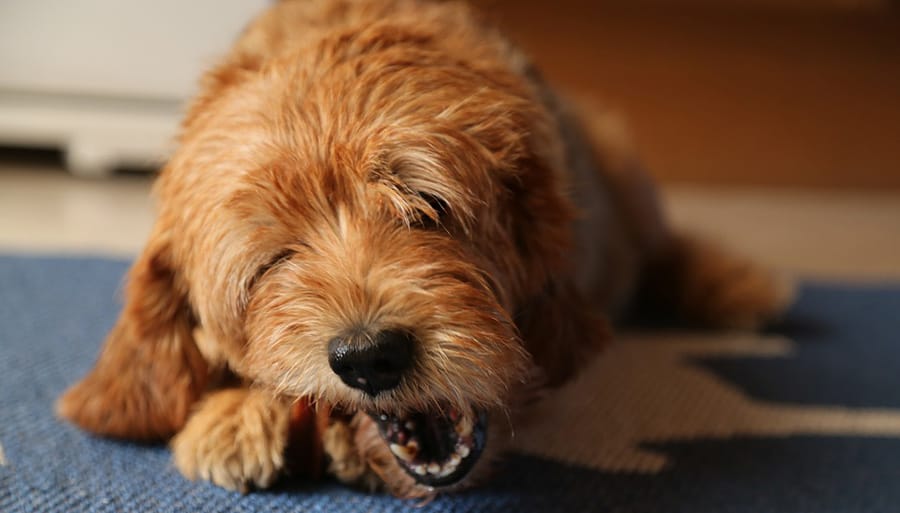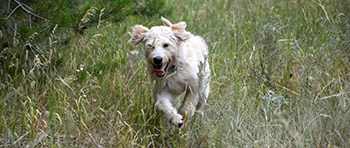
Thankfully, puppy teething is only temporary and relatively short-lived. We have all heard horror stories of ruined slippers, destroyed books, and chewed-up table legs, but if you are armed with the knowledge of the teething process and some teething survival tips, your story can have a happy ending.
So, for how long do Labradoodle puppies teethe? The entire teething process can take as long as 7 months. It typically begins at 3 weeks of age, when their puppy teeth first start to appear. During the third month, their gums begin to absorb the roots of puppy teeth, making them loose. The puppy teeth are soon pushed out as the adult teeth erupt. By 8 months, most Labradoodles have all of their permanent adult teeth.
The term teething, when referring to human babies, usually refers to the time period when baby teeth are pushing up through the gums for the first time. However, when teething is used in reference to puppies, it usually refers to the process of losing the puppy teeth to make room for the permanent teeth. This might be a bit confusing, so let’s take a closer look at the entire process.
As an owner of 2 Labradoodles myself, I know how tough it can be to find good information. In the 60+ pages of this book, I share the information, resources, and breed-specific tips I wish I’d had from the start. You will save you time, money, and loads of frustration…take my word for it!
The Teething Stages Of Labradoodles
STAGE ONE
Almost all puppies are born without any teeth. This allows the mother to nurse her litter comfortably. When the rapidly growing puppies begin to require more than just mother’s milk, the first puppy teeth start to erupt, breaking through the gums. Within 3 – 4 weeks, the puppies’ incisors, canines, and premolars have usually appeared.
A puppy’s first set of teeth allow him to begin the transition to solid food, and by the age of 8 weeks, most puppies are fully weaned. As is the case with people, this first set of teeth act as placeholders, permitting the puppies to eat solid food until the permanent teeth are ready to come in. Approximately one month later, the second stage of teething begins.
STAGE TWO
The second stage of puppy teething involves the gradual loss of puppy teeth and the emergence of adult teeth. Over the course of 5 – 6 months, one by one, the puppy teeth are pushed out by the emerging permanent teeth. This is the time when the strong urge to chew can become a problem for puppies and their owners.
The second stage of teething is an ideal time to teach your puppy what is and what is not okay to put in his mouth. Every time you see him pick up or chew on something that he shouldn’t, remove the object and firmly tell him “No”. Instead, give them a chew toy and praise them for chewing that toy instead. Being diligent in this area now will establish good behavior in the future.
When Do Labradoodle Puppies Begin To Lose Their Teeth?
In the third month of your puppy’s life, his gums will actually begin to dissolve and absorb the roots of the puppy teeth. This makes it much easier for the tooth to fall out at the right time and prevents the puppy from being in any pain.
The actual loss of teeth begins with the incisors which tend to fall out when the puppy is between 12 – 16 weeks old. Next, are the canine teeth at around 16 weeks. Last, are the premolars at around week 24.
Did you know that puppy teeth do not include any molars? Molars are only a part of the permanent set of teeth.
You can read more about Labradoodles losing their puppy teeth, here.
What Happens To The Lost Teeth?
At around 3 months of age, a puppy’s gums begin to absorb the roots of the puppy (also called ‘deciduous teeth’ by veterinarians or ‘milk teeth by some) teeth, so when the teeth are lost they are actually quite small. In fact, there is a chance you will not even be aware that one has fallen out until you notice that an adult tooth has already taken its place.
Puppies have no control over where and when their little needles – I mean puppy teeth – fall out, so you might find them anywhere around your home. You might find one laying in your puppy’s bed after he gets up. One might be found embedded in a favorite chew toy or left behind in his food bowl.
Deciduous teeth can be lost while your puppy is chewing on toys (or your new pair of shoes), chowing down on food, or while running around the backyard at playtime. Occasionally, if a tooth falls out while he is busy with one of these activities, the tooth might be swallowed. There is no cause for alarm as this is perfectly normal, and the tooth should pass through his system without any problems.
When Do Their Adult Teeth Grow In?
It is the adult teeth that are responsible for literally pushing the puppy teeth out. By the time that a puppy tooth is lost, a new permanent tooth is already making its way to the surface of the gum.
Labradoodle puppies should have permanent incisors in place between 3 – 5 months of age. Adult canine teeth and the premolars make their appearance sometime between months 4 – 6. The molars are typically last to erupt and are usually in place between months 5-7.
Tips for Getting Through Puppy Teething
Teething is most likely harder on you than it is your puppy. Discovering that your sweet little dog has destroyed the legs of the kitchen table can certainly ruin your day and hurt your wallet. Disasters like this can be largely avoided by offering your puppy a variety of chewing options.
Consider investing in a crate (here’s our favorite crate) if you do not have one already. Keeping your puppy in a crate when you are not around will give you some peace of mind, knowing that your puppy is safe and, therefore, so are your belongings. Here are some other ideas to help both you and your pup survive the chewing phase.
- Most pet supply stores offer some sort of teething gel that can provide your puppy some relief.
- A Kong Puppy Teething Stick can not only soothe sore gums but can also help clean teeth as well.
- An inexpensive option is to freeze a healthy treat like a carrot. The cold will help numb his gums while he enjoys some “people” food.
- You can also try freezing a rolled-up (old) wet washcloth. This can really help soothe their gums and can easily be re-frozen and reused.
- There are many chew toys, like a Puppy Chew Bone, that are designed specifically for teething puppies. Try to provide a variety for your puppy to choose from. One that is soft, one that is hard, and a crunchy one are good choices.
- A Puppy Kong can be filled with a treat such as peanut butter and frozen to satisfy your puppy’s need to chew and lick while numbing his sore gums at the same time.
- Rope tug-of-war toys are great for puppies to chew on and provide lots of fun when you join in the game too.
Related Questions
When should you start brushing your Labradoodle’s teeth?
The sooner, the better. The ideal time is 8 – 12 weeks old. Start by rubbing a bit of dog-friendly toothpaste over the pup’s teeth with your finger. Later, you can switch to a child’s toothbrush and brush three times a week. Accustoming your dog now can save you some trouble in the future. Read more about Labradoodle teeth and watch our ‘How to’ teeth brushing video, here.
How many teeth do Labradoodles have?
After all the puppy teeth have fully emerged, a Labradoodle puppy will have a total of 28 which is eight more than a human baby has. An adult dog will have 42 permanent teeth while an adult person can only boast 32 if the wisdom teeth have been removed.
Things to Remember
Having a teething puppy does not have to be a nightmare. The natural process of acquiring permanent teeth can go quite smoothly if you know what to expect when to expect it, and how to properly deal with all of that chewing. Be patient with your Labradoodle puppy, because before you know it, he will be all grown up.





